The global thermal inkjet printer market is poised for significant growth, expanding from USD 12,847 million in 2025 to USD 19,652 million by 2035, reflecting a CAGR of 4.3%. Between 2025 and 2030, the market is expected to grow from USD 12,847 million to USD 16,038 million, adding USD 3,191 million, or 45% of the total decade growth. This phase will be marked by the rapid adoption of wireless connectivity systems, driven by increasing demand for reliable and efficient printing solutions across commercial, educational, and residential sectors. Enhanced color reproduction and energy-efficient features will become standard, addressing growing expectations for high-quality document production. Wireless and smart connectivity, along with the shift toward mobile-first solutions, will become key drivers of growth during this period.
From 2030 to 2035, the market is forecast to grow further from USD 16,038 million to USD 19,652 million, adding USD 3,614 million, which constitutes 55% of the growth for the decade. This period will see mass market penetration of multi-function printing systems, better integration with comprehensive document management platforms, and seamless compatibility with existing office infrastructure. These advancements will redefine how businesses and professionals approach printing solutions, emphasizing ease of use, efficiency, and versatility. The thermal inkjet printer market's trajectory signals demand across various application segments, with businesses benefiting from the widespread shift to advanced and integrated printing technologies.

The thermal inkjet printer market demonstrates distinct growth phases with varying market characteristics and competitive dynamics. Between 2025 and 2030, the market progresses through its technology adoption phase, expanding from USD 12,847 million to USD 16,038 million with steady annual increments averaging 4.5% growth. This period showcases the transition from basic printing solutions to advanced systems with enhanced color accuracy and integrated connectivity features becoming mainstream capabilities.
The 2025-2030 phase adds USD 3,191 million to market value, representing 45% of total decade expansion. Market maturation factors include standardization of wireless protocols, declining component costs for printhead materials, and increasing consumer awareness of inkjet benefits reaching 75-80% effectiveness in document production. Competitive landscape evolution during this period features established manufacturers like HP Inc. and Canon Inc. expanding their thermal inkjet portfolios while new entrants focus on specialized formulations and enhanced printing efficiency.
From 2030 to 2035, market dynamics shift toward advanced integration and multi-device deployment, with growth accelerating from USD 16,038 million to USD 19,652 million, adding USD 3,614 million or 55% of total expansion. This phase transition logic centers on universal printing systems, integration with cloud-based document management networks, and deployment across diverse office scenarios, becoming standard rather than specialized applications. The competitive environment matures with focus shifting from basic printing capability to comprehensive document systems and integration with enterprise workflow platforms.
| Metric | Value |
|---|---|
| Market Value (2025) | USD 12,847 million |
| Market Forecast (2035) | USD 19,652 million |
| Growth Rate | 4.3% CAGR |
| Leading Technology | Desktop |
| Primary Application | Commercial & Office Segment |
The market demonstrates strong fundamentals with desktop systems capturing a dominant share through advanced printing quality and reliable deployment capabilities. Commercial and office applications drive primary demand, supported by increasing business spending on advanced document systems and workflow management solutions. Geographic expansion remains concentrated in developed markets with established office infrastructure, while emerging economies show accelerating adoption rates driven by business modernization and rising productivity requirements.
Market expansion rests on three fundamental shifts driving adoption across office automation and business sectors. 1. Advanced printing demand creates compelling operational advantages through thermal inkjet systems that provide high-quality document output with reliable performance, enabling businesses to enhance productivity while maintaining professional standards and reducing operational costs. 2. Digital transformation programs accelerate as organizations worldwide seek advanced printing systems that complement traditional office equipment, enabling precise document solutions that align with workflow goals and quality certification requirements. 3. Infrastructure enhancement drives adoption from commercial and educational facilities requiring effective printing solutions that minimize equipment downtime while maintaining operational standards during critical applications.
The growth faces headwinds from ink consumption challenges that vary across user types regarding cartridge replacement frequency and cost considerations, potentially limiting deployment flexibility in certain business environments. Technical limitations also persist regarding print speed capabilities and media compatibility that may increase operational costs in high-volume applications with demanding performance standards.
The thermal inkjet printer market represents a compelling intersection of office automation, digital transformation, and productivity management. With robust growth projected from USD 12,847 million in 2025 to USD 19,652 million by 2035 at a 4.30% CAGR, this market is driven by increasing business digitalization, commercial infrastructure upgrades, and regulatory pressures for efficient document practices.
The market's expansion reflects a fundamental shift in how businesses and professionals approach printing infrastructure. Strong growth opportunities exist across diverse applications, from commercial operations requiring reliable document quality to educational facilities demanding advanced printing standards. Geographic expansion is particularly pronounced in Asia-Pacific markets, LED by India (5.6% CAGR) and China (5.2% CAGR), while established markets in North America and Europe drive premium positioning and technology innovation.
The dominance of desktop systems and commercial applications underscores the importance of proven printing technology and operational reliability in driving adoption. Application complexity and infrastructure compatibility remain key challenges, creating opportunities for companies that can simplify deployment while maintaining performance standards.
Primary Classification: The market segments by product type into desktop, portable, and industrial categories, representing the evolution from basic printing systems to advanced production solutions for comprehensive document operations.
Secondary Breakdown: Application segmentation divides the market into commercial & office, residential, educational, healthcare, and others sectors, reflecting distinct requirements for printing standards, facility integration, and regulatory compliance.
Regional Classification: Geographic distribution covers North America, Europe, Asia Pacific, Latin America, and the Middle East & Africa, with developed markets leading adoption while emerging economies show accelerating growth patterns driven by business modernization programs.
The segmentation structure reveals technology progression from desktop printing systems toward integrated multi-function platforms with enhanced connectivity and monitoring capabilities, while application diversity spans from commercial operations to educational facilities requiring precise document management solutions.

Desktop segment is estimated to account for 56% of the thermal inkjet printer market share in 2025. The segment's leading position stems from its fundamental role as a critical component in office printing applications and its extensive use across multiple business sectors. Desktop printer dominance is attributed to its superior balance of functionality, including document quality, compact design, and connectivity capabilities that make it indispensable for office automation operations.
Market Position: Desktop systems command the leading position in the thermal inkjet printer market through advanced printing features, including comprehensive color management, extended cartridge life, and reliable performance that enable businesses to deploy advanced document solutions across diverse office environments.
Value Drivers: The segment benefits from business preference for proven printing technology that provides professional output quality without requiring complex infrastructure modifications. Reliable design features enable deployment in office environments, commercial facilities, and home office applications where performance and cost-effectiveness represent critical operational requirements.
Competitive Advantages: Desktop systems differentiate through rapid printing capability, proven document quality, and compatibility with standard office networks that enhance business productivity while maintaining cost-effective operational profiles suitable for diverse printing applications.
Key market characteristics:
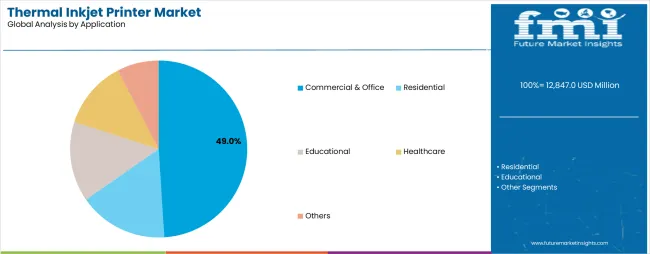
Commercial & office segment is projected to hold 49% of the thermal inkjet printer market share in 2025. The segment's market leadership is driven by the extensive use of thermal inkjet printers in document production, presentation materials, marketing collateral, and administrative tasks, where printers serve as both productivity tools and quality enablers. The business sector's consistent demand for high-quality, reliable printing equipment supports the segment's dominant position.
Market Context: Commercial applications dominate the market due to widespread adoption of advanced printing technology and increasing focus on document quality management, operational efficiency, and workflow optimization applications that enhance productivity standards while maintaining professional output.
Appeal Factors: Commercial customers prioritize equipment reliability, output consistency, and integration with existing office infrastructure that enables coordinated deployment across multiple business systems. The segment benefits from substantial technology budgets and modernization programs that emphasize efficiency enhancement for administrative and marketing operations.
Growth Drivers: Digital transformation programs incorporate thermal inkjet printers as standard equipment for document management and communication applications. At the same time, enterprise initiatives are increasing demand for high-quality printing that complies with brand standards and enhances professional presentation.
Market Challenges: Connectivity requirements and software compatibility issues may limit deployment flexibility in certain system types or legacy infrastructure scenarios.
Application dynamics include:
Growth Accelerators: Digital transformation drives primary adoption as thermal inkjet printer systems provide reliable document capabilities that enable professional output without complex setup, supporting workflow efficiency and operational productivity that require precise document management. Business demand accelerates market expansion as organizations seek effective printing solutions that minimize equipment costs while maintaining quality standards during critical applications and office management operations. Technology spending increases worldwide, creating demand for advanced printing systems that complement digital workflows and provide operational flexibility in complex business environments.
Growth Inhibitors: Ink consumption challenges vary across user types regarding cartridge replacement frequency and cost considerations, which may limit deployment flexibility and market penetration in businesses with restrictive operational budgets. Technical performance limitations persist regarding print speed capabilities and media compatibility that may increase operational costs in high-volume environments with demanding output requirements. Market fragmentation across multiple connectivity standards and software platforms creates compatibility concerns between different printer manufacturers and existing office infrastructure.
Market Evolution Patterns: Adoption accelerates in commercial and small business sectors where professional printing justifies equipment costs, with geographic concentration in developed markets transitioning toward mainstream adoption in emerging economies driven by business modernization and infrastructure development. Technology development focuses on enhanced wireless capabilities, improved ink efficiency, and integration with cloud-based document systems that optimize printing workflows and cost monitoring. The market could face disruption if alternative printing technologies or digital document preferences significantly limit thermal inkjet deployment in commercial or office applications.
The thermal inkjet printer market demonstrates varied regional dynamics with Growth Leaders including India (5.6% CAGR) and China (5.2% CAGR) driving expansion through business modernization and digital infrastructure development. Steady Performers encompass the USA (5.0% CAGR), Germany (4.6% CAGR), and Japan (4.2% CAGR), benefiting from established commercial sectors and advanced technology adoption.
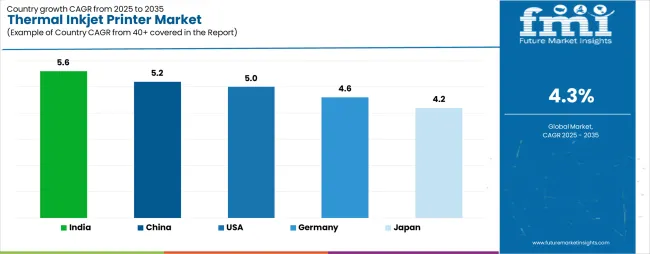
| Country | CAGR (2025-2035) |
|---|---|
| India | 5.6% |
| China | 5.2% |
| USA | 5.0% |
| Germany | 4.6% |
| Japan | 4.2% |
Regional synthesis reveals Asia-Pacific markets leading growth through business digitalization and infrastructure development, while European countries maintain steady expansion supported by technology advancement and office modernization requirements. North American markets show strong growth driven by commercial applications and enterprise facility integration trends.
India establishes regional leadership through aggressive digital transformation programs and comprehensive business infrastructure development, integrating advanced thermal inkjet printer systems as standard equipment in commercial and educational applications. The country's 5.6% CAGR through 2035 reflects government initiatives promoting digital literacy and domestic technology capabilities that encourage the use of advanced printing systems in office and institutional operations. Growth concentrates in major business centers, including Mumbai, Delhi, and Bangalore, where office modernization showcases integrated printing systems that appeal to domestic enterprises seeking advanced document solutions and operational efficiency applications.
Indian manufacturers are developing cost-effective thermal inkjet solutions that combine domestic production advantages with advanced features, including wireless connectivity systems and cloud integration capacity.
Strategic Market Indicators:
The Chinese market emphasizes large-scale commercial deployment, including rapid business expansion and comprehensive infrastructure development that increasingly incorporates thermal inkjet printers for document production and office automation applications. The country is projected to show a 5.2% CAGR through 2035, driven by massive digital transformation investments under business development programs and commercial demand for reliable, cost-effective printing systems. Chinese commercial facilities prioritize operational effectiveness with thermal inkjet printers delivering consistent performance through advanced printing quality and connectivity capabilities.
Technology deployment channels include major office equipment suppliers, specialized technology distributors, and institutional procurement programs that support professional installation for complex business applications.
Performance Metrics:
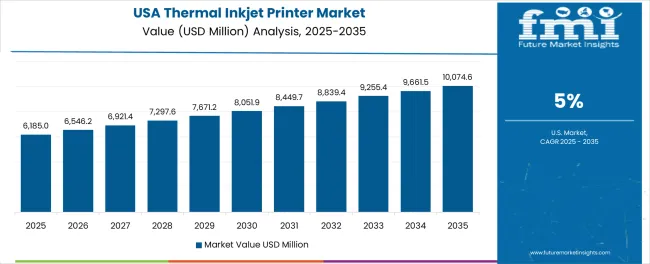
The USA market emphasizes advanced thermal inkjet features, including precision color systems and integration with comprehensive workflow platforms that manage document production, supply tracking, and usage monitoring applications through unified office systems. The country is projected to show a 5.0% CAGR through 2035, driven by office modernization under digital transformation initiatives and commercial demand for reliable, advanced printing systems. American commercial facilities prioritize operational effectiveness with thermal inkjet printers delivering consistent performance through advanced printhead technology and connectivity capabilities.
Technology deployment channels include major office equipment distributors, specialized technology providers, and enterprise procurement programs that support professional deployment for complex business operations.
Performance Metrics:
In Frankfurt, Munich, and Hamburg, German commercial facilities and business enterprises are implementing advanced thermal inkjet printer systems to enhance document production capabilities and support operational efficiency that aligns with quality requirements and workflow protocols. The German market demonstrates growth with a 4.6% CAGR through 2035, driven by office modernization programs and business equipment upgrades that emphasize advanced printing systems for commercial and administrative applications. German commercial facilities are prioritizing thermal inkjet systems that provide reliable document quality while maintaining compliance with efficiency standards and minimizing operational costs, particularly important in professional services and corporate operations.
Market expansion benefits from business excellence programs that mandate high-performance equipment in office facility specifications, creating demand across Germany's commercial and service sectors, where document quality and operational reliability represent critical requirements.
Strategic Market Indicators:
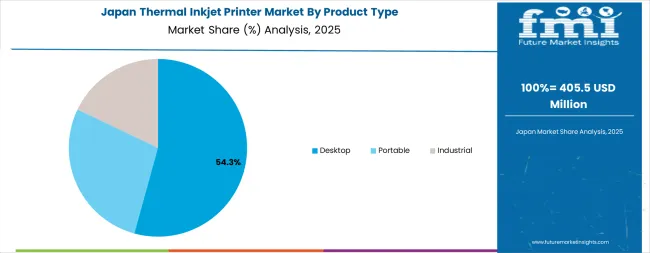
The advanced commercial market in Japan demonstrates sophisticated thermal inkjet deployment, growing at 4.2% CAGR, with documented operational effectiveness in corporate offices and educational applications through integration with existing document systems and quality control infrastructure. The country leverages engineering expertise in imaging technology and precision manufacturing to maintain market leadership. Business centers, including Tokyo, Osaka, and Yokohama, showcase premium installations where thermal inkjet systems integrate with comprehensive workflow platforms and document management systems to optimize printing operations and operational effectiveness.
Japanese commercial facilities prioritize system reliability and print quality standards in equipment development, creating demand for premium printer systems with advanced features, including enhanced color control and integration with automated office systems. The market benefits from established business infrastructure and willingness to invest in advanced printing technologies that provide long-term operational benefits and compliance with quality standards.
Market Intelligence Brief:
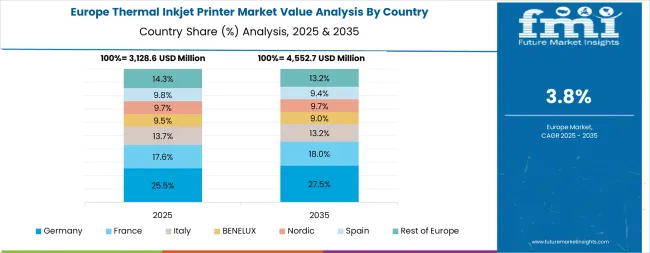
The thermal inkjet printer market in Europe is projected to grow from USD 3,785 million in 2025 to USD 5,947 million by 2035, registering a CAGR of 4.6% over the forecast period. Germany is expected to maintain its leadership position with a 31.8% market share in 2025, declining slightly to 31.4% by 2035, supported by its advanced business infrastructure and major commercial centers, including Bavaria and North Rhine-Westphalia.
The United Kingdom follows with a 24.3% share in 2025, projected to reach 24.6% by 2035, driven by comprehensive digital transformation and office automation initiatives. France holds a 19.7% share in 2025, expected to maintain 19.9% by 2035 through established commercial sectors and office technology adoption. Italy commands a 14.2% share, while Spain accounts for 7.4% in 2025. The Rest of Europe region is anticipated to gain momentum, expanding its collective share from 2.6% to 2.8% by 2035, attributed to increasing business adoption in Nordic countries and emerging Eastern European commercial facilities implementing advanced office automation programs.
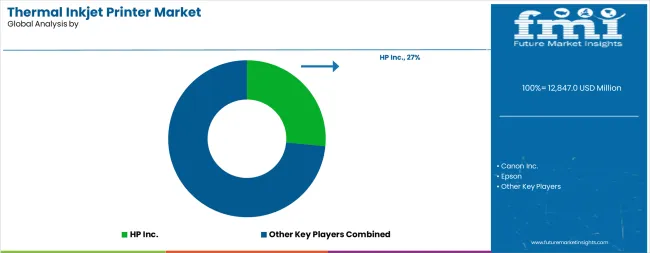
The thermal inkjet printer market operates with moderate concentration, featuring approximately 15-22 participants, where leading companies control roughly 55-60% of the global market share through established brand recognition and comprehensive product portfolios. Competition emphasizes printing quality, technology innovation, and connectivity features rather than price-based rivalry.
Market Leaders encompass HP Inc., Canon Inc., and Epson, which maintain competitive advantages through extensive imaging technology expertise, global distribution networks, and comprehensive customer support capabilities that create brand loyalty and support premium positioning. These companies leverage decades of printing industry experience and ongoing research investments to develop advanced thermal inkjet systems with enhanced color accuracy and efficiency features.
Technology Challengers include Brother Industries, Lexmark International, and Samsung Electronics, which compete through specialized technology focus and innovative printhead interfaces that appeal to business customers seeking advanced printing capabilities and operational flexibility. These companies differentiate through rapid product development cycles and specialized commercial application focus.
Market dynamics favor participants that combine reliable printing technology with advanced connectivity support, including mobile printing and cloud integration capabilities. Competitive pressure intensifies as traditional office equipment manufacturers expand into thermal inkjet systems. At the same time, specialized technology companies challenge established players through innovative document solutions and cost-effective products targeting specialized business segments.
| Item | Value |
|---|---|
| Quantitative Units | USD 12,847 million |
| Product Type | Desktop, Portable, Industrial |
| Application | Commercial & Office, Residential, Educational, Healthcare, Others |
| Regions Covered | North America, Europe, Asia Pacific, Latin America, Middle East & Africa |
| Countries Covered | USA, Germany, Japan, India, China, and 25+ additional countries |
| Key Companies Profiled | HP Inc., Canon Inc., Epson, Brother Industries, Lexmark International, Samsung Electronics |
| Additional Attributes | Dollar sales by product type and application categories, regional adoption trends across North America, Europe, and Asia-Pacific, competitive landscape with equipment manufacturers and technology suppliers, business preferences for reliability and output quality, integration with document management platforms and workflow systems, innovations in printhead technology and connectivity efficiency, and development of multi-function solutions with enhanced printing and scanning capabilities |
The global thermal inkjet printer market is estimated to be valued at USD 12,847.0 million in 2025.
The market size for the thermal inkjet printer market is projected to reach USD 19,572.4 million by 2035.
The thermal inkjet printer market is expected to grow at a 4.3% CAGR between 2025 and 2035.
The key product types in thermal inkjet printer market are desktop, portable and industrial.
In terms of application, commercial & office segment to command 49.0% share in the thermal inkjet printer market in 2025.






Full Research Suite comprises of:
Market outlook & trends analysis
Interviews & case studies
Strategic recommendations
Vendor profiles & capabilities analysis
5-year forecasts
8 regions and 60+ country-level data splits
Market segment data splits
12 months of continuous data updates
DELIVERED AS:
PDF EXCEL ONLINE
Examining Market Share Trends in the Thermal Inkjet Printer Industry
Thermal & Inkjet Disc Printers Market Analysis by Ribbon Type, Supplier, Technology, and Region Through 2035
Thermal Interface Material Market Size and Share Forecast Outlook 2025 to 2035
Thermal Management Market Forecast and Outlook 2025 to 2035
Thermal Impulse Sealers Market Size and Share Forecast Outlook 2025 to 2035
Thermal Insulation Materials for Optical Fibers Market Size and Share Forecast Outlook 2025 to 2035
Thermal Insulation Material Market Size and Share Forecast Outlook 2025 to 2035
Thermal-Wet Gas Abatement System Market Size and Share Forecast Outlook 2025 to 2035
Thermal Spray Service Market Size and Share Forecast Outlook 2025 to 2035
Thermal Management Materials for EV Batteries Market Size and Share Forecast Outlook 2025 to 2035
Thermal Barrier Coatings Market Size and Share Forecast Outlook 2025 to 2035
Thermal Energy Harvesting Market Size and Share Forecast Outlook 2025 to 2035
Thermally Stable Antiscalant Market Size and Share Forecast Outlook 2025 to 2035
Thermal Spa and Wellness Market Size and Share Forecast Outlook 2025 to 2035
Thermal Mixing Valves Market Size and Share Forecast Outlook 2025 to 2035
Thermal Liner Market Analysis Size and Share Forecast Outlook 2025 to 2035
Thermal Insulation Coating Market Size and Share Forecast Outlook 2025 to 2035
Thermal Spray Equipment Market Size and Share Forecast Outlook 2025 to 2035
Thermal Spring Market Size and Share Forecast Outlook 2025 to 2035
Thermal Printing Market Analysis - Size, Share & Forecast 2025 to 2035

Thank you!
You will receive an email from our Business Development Manager. Please be sure to check your SPAM/JUNK folder too.
Chat With
MaRIA